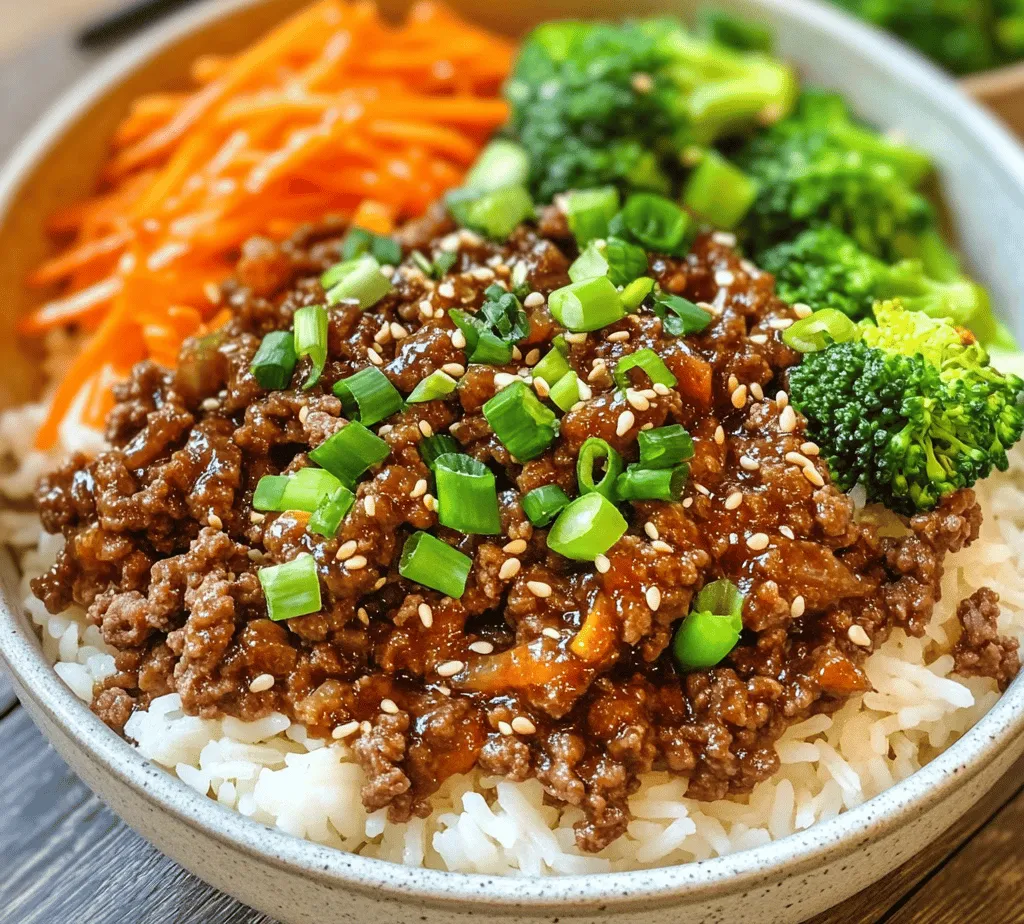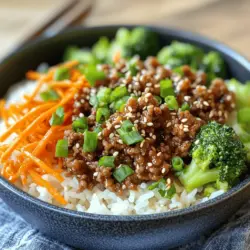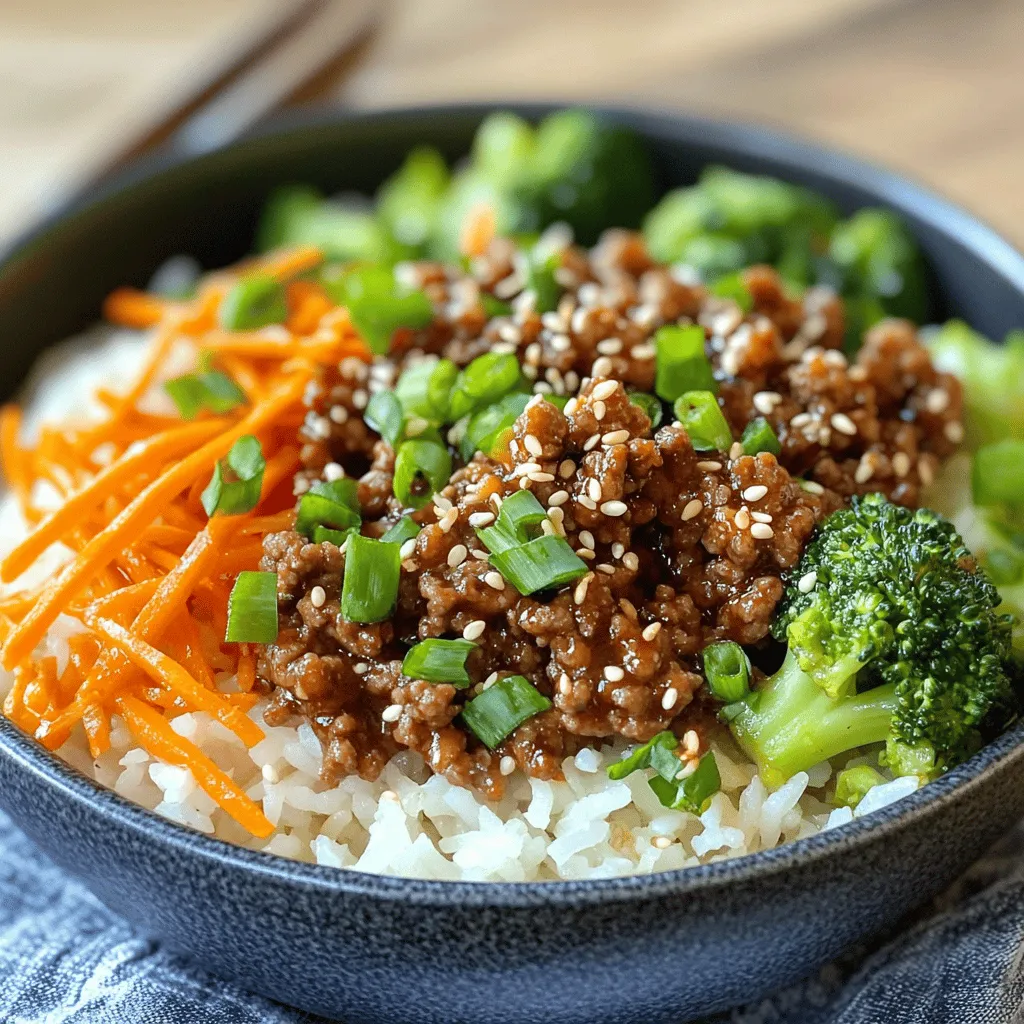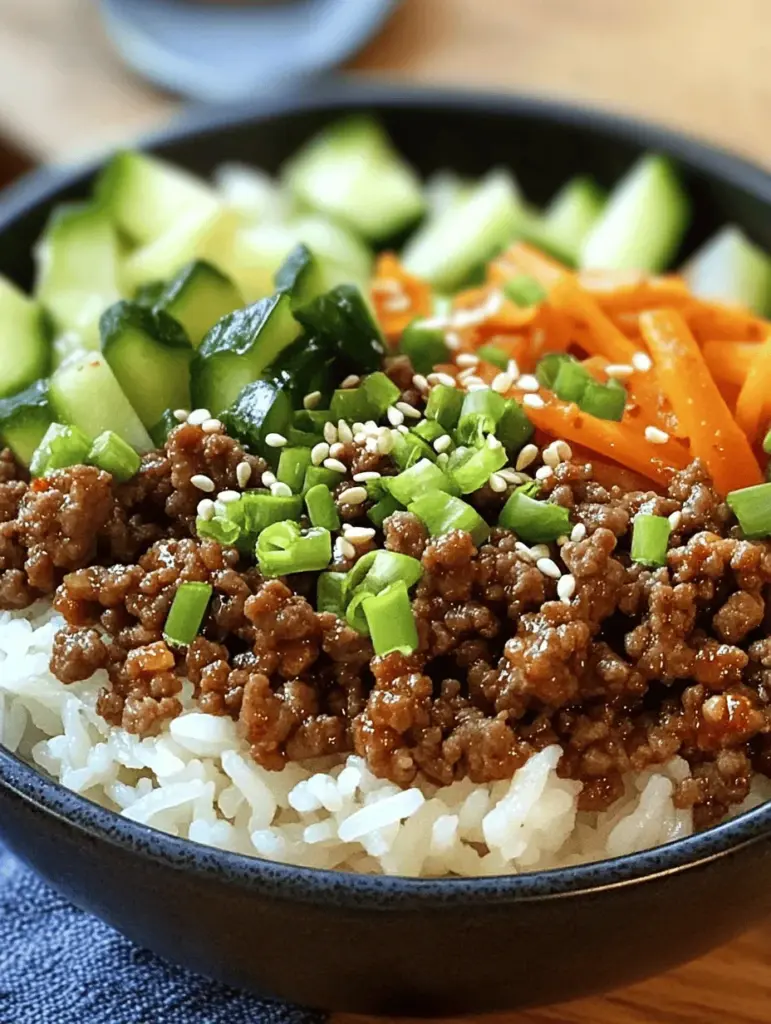Introduction: The Allure of Korean Cuisine
Korean cuisine has gained immense popularity around the globe, celebrated for its vibrant flavors, rich textures, and colorful presentations. Dishes are often characterized by their bold profiles, which combine sweet, savory, spicy, and umami elements to create an unforgettable culinary experience. At the heart of this culinary tradition lies the Korean Ground Beef Bowl, a delightful and satisfying dish that encapsulates the essence of Korean cooking.
This hearty meal features ground beef marinated in a flavorful sauce, served atop a bed of fluffy rice and accompanied by fresh vegetables. Not only is it a quick and easy dish to prepare, but it also brings the warm and inviting atmosphere of a Korean kitchen right into your home. In this article, we will explore the key ingredients that make this dish special, provide detailed step-by-step instructions for preparation, and discuss the cultural significance behind this beloved meal. Whether you are a seasoned cook or a novice in the kitchen, this recipe is sure to be a hit at your next family dinner or weeknight meal.
Understanding the Key Ingredients
To fully appreciate the Korean Ground Beef Bowl, it’s essential to understand the role of each ingredient in the dish. The combination of flavors and textures creates a symphony of taste that is both satisfying and nutritious.
Ground Beef
Ground beef is the star of the dish, providing a rich source of protein and a robust flavor that serves as the foundation for the meal. When cooked properly, it retains its juiciness and absorbs the flavors from the seasoned sauce, making every bite deliciously satisfying. Opting for a leaner cut of beef can help reduce the overall fat content while still delivering on flavor.
Soy Sauce and Brown Sugar
The marriage of soy sauce and brown sugar creates a perfect balance of salty and sweet in this recipe. Soy sauce introduces a savory depth that enhances the beef, while brown sugar adds a touch of sweetness to counteract the saltiness. This harmonious blend is a hallmark of Korean cuisine, where contrasting flavors come together to elevate the dish.
Sesame Oil
Sesame oil is a key ingredient in Korean cooking, known for its distinctive nutty flavor. It is often used both as a cooking oil and as a finishing touch to impart richness to the dish. A little goes a long way, making it essential to use the right amount to achieve the desired flavor without overpowering the other ingredients.
Aromatic Vegetables
Aromatics such as garlic, ginger, and green onions play a crucial role in building the flavor base of the Korean Ground Beef Bowl. Garlic and ginger provide a pungent, zesty kick, while green onions add freshness and a mild onion flavor. These ingredients work in tandem to create an aromatic background that enhances the overall taste of the dish.
Vegetables
In addition to the beef and sauce, colorful vegetables like carrots and broccoli not only add nutrition but also contribute vibrant colors and textures to the bowl. Carrots bring sweetness and crunch, while broccoli adds a slightly bitter note that balances the dish. Feel free to include other vegetables according to your preference, as this dish is highly customizable.
Gochujang
One cannot talk about Korean cuisine without mentioning gochujang, a fermented chili paste that adds depth and a hint of heat to the dish. Made from red chili powder, glutinous rice, fermented soybeans, and salt, gochujang is a staple in Korean kitchens. Its complex flavor profile enhances the savory elements of the beef while providing a subtle warmth that lingers on the palate.
Jasmine Rice
Finally, jasmine rice serves as the aromatic base for the bowl. This long-grain rice is known for its fragrant aroma and slightly sticky texture, making it the perfect accompaniment to soak up the flavors of the beef mixture. The fluffy rice helps to balance the richness of the beef and vegetables, providing a satisfying contrast.
Preparation and Cooking Process
Now that we’ve explored the key ingredients, it’s time to dive into the preparation and cooking process for the Korean Ground Beef Bowl. Understanding the steps involved will make your cooking experience smoother and more enjoyable.
Prep Time and Ingredients Overview
Before you start cooking, it’s essential to gather all the ingredients and tools you will need. This dish typically requires about 10-15 minutes of prep time and 15-20 minutes of cooking time, making it a quick and convenient option for busy weeknights. Here’s a quick overview of what you’ll need:
Ingredients:
- 1 pound ground beef (preferably lean)
- 2 tablespoons soy sauce
- 1 tablespoon brown sugar
- 2 teaspoons sesame oil
- 3 cloves garlic, minced
- 1 teaspoon fresh ginger, grated
- 2 green onions, thinly sliced (plus more for garnish)
- 1 cup broccoli florets
- 1 cup shredded carrots
- 1 tablespoon gochujang (adjust to taste)
- 2 cups cooked jasmine rice
- Sesame seeds for garnish (optional)
Step-by-Step Instructions
Cooking the Ground Beef: Achieving the Perfect Texture
1. Heat a Skillet: Begin by heating a large skillet or wok over medium-high heat. Add a small drizzle of sesame oil to prevent sticking and enhance flavor.
2. Brown the Beef: Once the skillet is hot, add the ground beef. Use a spatula to break it apart as it cooks, ensuring even browning. This process should take about 5-7 minutes. Cook until the beef is no longer pink and starts to caramelize slightly, which will add depth to the flavor.
Infusing Flavor: The Importance of Aromatics in Building Flavor
3. Add Aromatics: After the beef is cooked, push it to one side of the skillet. In the empty space, add the minced garlic and grated ginger. Let them cook for about 30 seconds, stirring frequently to prevent burning. The goal is to release their aromas and flavors into the beef.
4. Combine Ingredients: Once the garlic and ginger are fragrant, mix them with the ground beef. This step ensures that the aromatic flavors permeate the meat evenly.
Balancing the Sauce: How to Create the Ideal Sauce Consistency
5. Create the Sauce: In a small bowl, whisk together the soy sauce, brown sugar, and gochujang until well combined. Pour this mixture over the beef, and stir to coat evenly. Allow the sauce to simmer for an additional 2-3 minutes, allowing the flavors to meld and the sauce to thicken slightly.
Incorporating Vegetables: Timing and Technique for the Best Results
6. Add Vegetables: It’s time to incorporate the vegetables. Add the broccoli florets and shredded carrots to the skillet, stirring them into the beef mixture. Cook for another 3-4 minutes, or until the vegetables are tender-crisp. This technique helps maintain their vibrant colors and nutritional value.
Assembling the Bowl: Presentation Tips for an Appealing Meal
7. Prepare the Rice: While the beef and vegetables are cooking, prepare your jasmine rice according to package instructions. Fluff it with a fork to ensure a light and airy texture.
8. Assemble the Bowl: To serve, place a generous scoop of jasmine rice at the bottom of each bowl. Top it with the ground beef and vegetable mixture, allowing the sauce to drizzle down the sides.
Garnishing: Elevating Your Dish’s Aesthetic with Sesame Seeds and Green Onions
9. Add Finishing Touches: For an elegant presentation, sprinkle sesame seeds and additional sliced green onions on top of the dish. This not only enhances the visual appeal but also adds an extra layer of flavor.
As you can see, preparing a Korean Ground Beef Bowl is a straightforward process that yields delicious results. This dish is not only a feast for the senses but also a great way to introduce the vibrant flavors of Korean cuisine into your home. In the next section, we will delve into the nutritional analysis of this hearty meal, allowing you to appreciate its health benefits while enjoying every bite.

How the Vegetables Contribute to Your Daily Nutritional Needs
In the Korean Ground Beef Bowl, vegetables play a vital role, not only in enhancing the flavor and texture of the dish but also in providing essential nutrients that contribute to your overall health. Incorporating a variety of vegetables, such as carrots, bell peppers, and green onions, ensures you’re getting a well-rounded intake of vitamins and minerals.
1. Carrots: Packed with beta-carotene, which the body converts into vitamin A, carrots are excellent for eye health. They also contain antioxidants that help reduce inflammation and support the immune system.
2. Bell Peppers: Rich in vitamins A and C, bell peppers are known for their anti-inflammatory properties. They also provide fiber, which aids in digestion and helps maintain a healthy gut.
3. Green Onions: These flavorful additions not only enhance the dish with their mild onion-like taste but are also low in calories and rich in vitamins K and C. They help in promoting heart health and have antibacterial properties.
By including these vegetables in your Korean Ground Beef Bowl, you enhance not just the taste but also the nutritional value of your meal, making it a wholesome option that can fit into a balanced diet.
Health Benefits of Key Ingredients
The Korean Ground Beef Bowl features several ingredients that contribute to its flavor and nutritional profile. Two key components, sesame oil and gochujang, are not only delicious but also packed with health benefits.
Sesame Oil
Sesame oil is a staple in Korean cuisine, offering a rich, nutty flavor that enhances any dish. Beyond its culinary appeal, sesame oil is loaded with antioxidants, such as sesamol and sesamin, which can help reduce oxidative stress in the body. It also contains healthy fats, specifically monounsaturated and polyunsaturated fats, which are essential for heart health. Moreover, sesame oil has anti-inflammatory properties, making it beneficial for those with inflammatory conditions.
Gochujang
Gochujang, a fermented Korean chili paste, is another critical ingredient in this bowl. It adds a depth of flavor that balances sweetness, heat, and umami. Beyond its taste, gochujang is rich in vitamins and minerals, including vitamin C, potassium, and iron. The fermentation process increases the presence of probiotics, which are beneficial for gut health. Additionally, the capsaicin found in chili peppers can boost metabolism and promote fat burning, making gochujang a smart choice for those looking to maintain a healthy weight.
Cultural Significance of Korean Bowls
Korean Cuisine and Its Global Influence
Korean cuisine has gained tremendous popularity in recent years, fueled by the Hallyu wave, or Korean cultural wave, which includes K-dramas, K-pop, and, of course, K-food. The Korean Ground Beef Bowl is a perfect example of how traditional Korean flavors have transcended borders, appealing to food enthusiasts around the globe. This dish encapsulates the essence of Korean cooking—simple, yet bold flavors that celebrate the use of fresh ingredients and complex seasoning.
The Role of Bowls in Korean Dining
In Korea, meals are typically served in bowls, emphasizing the importance of both presentation and communal eating. The bowl serves as a symbol of togetherness, encouraging diners to share and enjoy their meals together. Each component of the meal, from rice to side dishes, is served in its own bowl, allowing for a variety of flavors and textures to be enjoyed in one sitting. The Korean Ground Beef Bowl exemplifies this tradition, bringing together rice, protein, and vegetables in a harmonious way that invites sharing and connection.
Family and Sharing
Family-style meals are central to Korean culture. The act of gathering around a table to share food fosters relationships and strengthens bonds among family members and friends. The Korean Ground Beef Bowl is not just a meal; it’s an experience that brings people together. Whether it’s a weeknight dinner or a special occasion, this dish can easily be doubled or tripled, making it ideal for serving a group.
Variations and Adaptations
Protein Substitutions
While ground beef is the star of this dish, there are numerous protein alternatives you can use to accommodate different dietary needs or preferences. Ground chicken or turkey offers a lighter option, while tofu or tempeh is perfect for those following a vegetarian or vegan lifestyle. Each of these proteins can absorb the flavors of the marinade and sauce, ensuring that your bowl remains delicious regardless of the protein choice.
Vegetarian and Vegan Options
To create a vegetarian or vegan version of the Korean Ground Beef Bowl, consider substituting the ground beef with plant-based proteins like lentils or chickpeas, which are not only high in protein but also rich in fiber. You can also enhance the dish with additional vegetables such as zucchini or mushrooms to provide a satisfying texture. Using vegetable broth instead of beef broth in the sauce can keep the flavors robust while maintaining a plant-based profile.
Spice Levels
Adjusting the spice level to suit your palate is easy with the Korean Ground Beef Bowl. If you prefer a milder taste, you can reduce the amount of gochujang or choose a milder chili paste. Conversely, for those who enjoy heat, consider adding crushed red pepper flakes or extra gochujang to kick the spice up a notch. The beauty of this recipe lies in its flexibility, allowing you to customize it to your liking.
Serving Suggestions
Complementing Sides
To enhance your Korean Ground Beef Bowl, consider serving it alongside traditional Korean sides. Kimchi is a must-have; its tangy, spicy flavors contrast beautifully with the richness of the beef. Other side dishes you might include are pickled radishes, seasoned spinach (sigeumchi namul), or a light cucumber salad for a refreshing crunch. These sides not only add variety but also contribute to the overall flavor profile of the meal.
Beverage Pairings
Pairing your meal with the right beverages can elevate the dining experience. A crisp, cold Korean beer such as Hite or Cass complements the bold flavors of the dish. For non-alcoholic options, traditional Korean drinks like Sikhye (sweet rice drink) or a refreshing iced barley tea (bori cha) can cleanse the palate and enhance your meal.
Conclusion: A Taste of Korea at Home
The Korean Ground Beef Bowl is more than just a meal; it’s an invitation to explore the rich flavors and cultural heritage of Korea. By mastering this simple yet delicious recipe, you can bring a taste of Korean cuisine into your kitchen, delighting your family and friends with each bite. This dish not only satisfies hunger but also serves as a reminder of the joy of cooking and sharing meals together. Enjoy the process, savor the flavors, and embrace the cultural journey that comes with each Korean Ground Beef Bowl you create.
By incorporating various techniques and ingredients, this dish can be tailored to suit any dietary need or preference, making it a versatile choice for any occasion. Whether you’re cooking for a family dinner or hosting a gathering, the Korean Ground Beef Bowl promises to impress and satisfy, leaving you with a taste of Korea that you can easily recreate at home.


